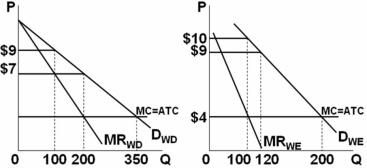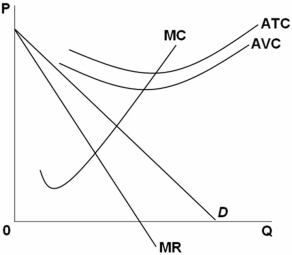A) output demand is relatively elastic.
B) firms have U-shaped average total cost curves.
C) fixed capital costs are small relative to total costs.
D) economies of scale are large relative to market demand.
F) A) and B)
Correct Answer

verified
Correct Answer
verified
Multiple Choice
A pure monopoly firm will never charge a price in the inelastic range of its demand curve because lowering price to get into this region will:
A) increase total revenue,increase total cost,and decrease profit.
B) decrease total revenue,increase total cost,and decrease profit.
C) increase total revenue,decrease total cost,and decrease profit.
D) decrease total revenue,total cost,and profit.
F) A) and C)
Correct Answer

verified
Correct Answer
verified
Multiple Choice
 Using the graph above,what is the difference between purely competitive and pure monopolist output at the industry level?
Using the graph above,what is the difference between purely competitive and pure monopolist output at the industry level?
A) 0
B) 35
C) 70
D) 105
The purely competitive level of output occurs where the demand curve crossed the MC curve,that is,160 units.The monopoly output occurs where MC = MR,that is,90 units.The difference is 70 units.
F) None of the above
Correct Answer

verified
Correct Answer
verified
Multiple Choice
Which is a major criticism of a monopoly as a source of allocative inefficiency?
A) A monopolist fails to expand output to the level where the consumers' valuation of an additional unit is just equal to the monopolist's opportunity cost.
B) A monopolist has no incentive to produce efficiently because even the inefficient monopolist can be assured of economic profits.
C) A monopolist will always make profits and that means that prices are too high.
D) A monopolist has an unfair advantage because it can purchase labor at a lower price than competitive firms in other industries.
F) C) and D)
Correct Answer

verified
Correct Answer
verified
Multiple Choice
What is the term that refers to increases in the value of a product to each user,including existing users,as the total number of users increases?
A) Income transfer
B) Price discrimination
C) Simultaneous consumption
D) Network effects
F) A) and D)
Correct Answer

verified
Correct Answer
verified
Multiple Choice
Successful price discrimination requires that:
A) buyers with inelastic demand be charged higher prices than buyers with elastic demand.
B) buyers with inelastic demand be charged lower prices than buyers with elastic demand.
C) all buyers be charged the same price regardless of their elasticity of demand.
D) all buyers have the same price elasticity of demand.
F) All of the above
Correct Answer

verified
Correct Answer
verified
Multiple Choice
A nondiscriminating pure monopolist's demand curve:
A) is perfectly inelastic.
B) coincides with its marginal revenue curve.
C) lies above its marginal revenue curve.
D) lies below its marginal revenue curve.
F) A) and C)
Correct Answer

verified
Correct Answer
verified
Multiple Choice
Under pure monopoly,a profit-maximizing firm will produce:
A) in the inelastic range of its demand curve.
B) in the elastic range of its demand curve.
C) only where total costs are zero.
D) only where marginal revenue is zero.
F) All of the above
Correct Answer

verified
Correct Answer
verified
True/False
The supply curve for a monopolist is the upsloping portion of the marginal cost curve that lies above the average variable cost curve.
B) False
Correct Answer

verified
Correct Answer
verified
Multiple Choice
 Refer to the figures above.Suppose the graphs represent the demand for use of a local golf course for which there is no significant competition (it has a local monopoly) .P denotes the price of a round of golf and Q is the quantity of rounds sold each day.If the left graph represents the demand during weekdays and the right graph the weekend demand,then over the course of a full seven-day week this price-discriminating,profit-maximizing golf course should sell a total of:
Refer to the figures above.Suppose the graphs represent the demand for use of a local golf course for which there is no significant competition (it has a local monopoly) .P denotes the price of a round of golf and Q is the quantity of rounds sold each day.If the left graph represents the demand during weekdays and the right graph the weekend demand,then over the course of a full seven-day week this price-discriminating,profit-maximizing golf course should sell a total of:
A) 300 rounds.
B) 740 rounds.
C) 900 rounds.
D) 1200 rounds.
The monopolist should set MC = MR in both markets.That means the weekday output should be 200 with a price of $7 and the weekend output should be 100 with a price of $10.This means 5 days of 100 rounds each and 200 weekend rounds for a total of 1200.
F) A) and C)
Correct Answer

verified
Correct Answer
verified
True/False
A price-discriminating monopolist will set a higher price when demand is more elastic and a lower price when demand is less elastic.
B) False
Correct Answer

verified
Correct Answer
verified
True/False
Unfair advertising practices are investigated by the Federal Trade Commission.
B) False
Correct Answer

verified
Correct Answer
verified
True/False
Without regulations,monopolists will produce at an output level where marginal benefit is greater than marginal social cost.
B) False
Correct Answer

verified
Correct Answer
verified
Multiple Choice
Consumers who clip and redeem discount coupons:
A) exhibit the same price elasticity of demand for a given product than consumers who do not clip and redeem coupons.
B) exhibit more price elasticity of demand for a given product than consumers who do not clip and redeem coupons.
C) exhibit less price elasticity of demand for a given product than consumers who do not clip and redeem coupons.
D) cause total revenue to decrease for firms that issue coupons for their products.
F) All of the above
Correct Answer

verified
Correct Answer
verified
Multiple Choice
A firm will earn economic profits whenever:
A) marginal revenue exceeds marginal costs.
B) marginal revenue exceeds variable costs.
C) average revenue exceeds average total costs.
D) average revenue exceeds average variable costs.
F) B) and C)
Correct Answer

verified
Correct Answer
verified
Multiple Choice
 A profit-maximizing monopolist facing the situation shown in the graph above should:
A profit-maximizing monopolist facing the situation shown in the graph above should:
A) shut down immediately.
B) continue producing to minimize losses.
C) continue producing to make economic profits.
D) continue producing as long as price is greater than marginal cost.
F) None of the above
Correct Answer

verified
Correct Answer
verified
Multiple Choice
Which is a barrier to entry in an industry?
A) Economies of scale
B) Allocative efficiency
C) Profit maximization
D) Economic profits
F) A) and B)
Correct Answer

verified
Correct Answer
verified
Multiple Choice
One feature of pure monopoly is that the monopolist is:
A) a producer of products with close substitutes.
B) one of several producers of a product.
C) a price taker.
D) a price maker.
F) A) and C)
Correct Answer

verified
Correct Answer
verified
Multiple Choice
Which is true of a price discriminating pure monopolist?
A) P > MR for the last unit sold.
B) Profit will be lower than in the nondiscriminating case.
C) The average price will be higher than in the nondiscriminating case.
D) Allocative inefficiency will be greater than in the nondiscriminating case.
F) None of the above
Correct Answer

verified
Correct Answer
verified
True/False
Rent-seeking behavior refers to activities designed to transfer income or wealth to a particular firm or resource supplier at someone else's or society's expense.
B) False
Correct Answer

verified
Correct Answer
verified
Showing 101 - 120 of 150
Related Exams